-
Posts
587 -
Joined
-
Last visited
Content Type
Profiles
Forums
Blogs
Gallery
Events
Store
Posts posted by Jef
-
-
Arty? Fusilier? ??
Seems to be a badge of the Grenadiers ( post WWII). I'm not a specialist on this topic ( Belgian post WWII badges),I used an excelent reference work of Urbain Huyghebaert, "Evolutie van de Belgische Militaire Kentekens 1830-2010"
Kind regards,
Jef
0 -
Reminds me of SAS?
Hello Hugh,
Belgian 2nd Bn. Commando ( green berets). Bronze for troopers, silver for NCO's and gold coloured badges for officers,
Jef
0 -
In 1968, I accompanied my admiral to a meeting of the NATO Naval Armaments Group (he was chairman). Whilst in Brussels, I raided the medals and military shops, and brought home the following badges (in addition to a slew of medals). Any notes i may have made have long since disappeared. Some of the symbolism seems self evident (artillery, light infantry, etc.), but it's so easy to be misled. Can someone help, please?
Thanks,
Hugh
Hello Hugh,
Bronze badge for privates ROAC ( Royal Army Ordnance Corps)post WWII
Jef
0 -
Equipment used by South African forces in WW1 varied greatly and can be analysed according to the various campaigns and theaters.
The Pattern 1903 Bandolier Equipment was used by South African Artillerymen in East Africa, Palestine and also by the South African batteries of the Royal Garrisson Artillery on the Western Front. Only the 50 round bandolier, water bottle and haversack were worn and used.
Large numbers of german leather equiment had been captured during the German South West African Campaign and these sets were used mainly by the machine gun elements of the South African Mounted Riflemen in German East Africa. This equipment is better known as the "Schutztruppen" or Mounted equiment.
Some sub-units in East Africa were issued with the Pattern 1908 Web Infantry Equipment but this was very limited ("A " Company of the 6th SAI). Most units used the 50 and 60 round bandoliers.
The Battalions of the Cape Corps were issued with Pattern 1908 Web Infantry Equipment and they used the equipment in both German East Africa and Palestine.
The South African Infantry regiments that fought on the Western Front were mainly issued with the Pattern 1914 Leather Infantry Equipment so they DID use and wear the "snake-buckle" belt.
Some photographic evidence exists of individual memebrs of these regiments wearing the Pattern 1908 Web Infantry Equipment.
I am fortunate to have complete sets or examples of these items in my collection.
Regards,
Will
Hello Will,
Thank you for your answer about the snake buckle belt. Much appreciated.
Kind regards,
Jef
0 -
Sorry about that Jef,
I'm off to a great start misspelling you name.
Dave
Hello Dave,
I'm really impressed by your knowledge about these snake buckles.Thank you for sharing your knowledge. About the misspelling of my name, don't worry.
Kind regards from Flanders,
Jef
0 -
Hi,
I was away on a business trip with no connection to the Net. Now that I am back I will try to answer your questions.
The decoration was established as early as in 1946 in three lower classes, the two upper ones being added in 1980. All insignia, regardless the class should be in silver. Jef's class is an Officer or Member. The cross should have a silver finish, but in may have worn away with time. It looks like an early, pre-1980 production. The ribbon is similar to that of the Polish Independence Cross - black with red side stripes, but the stripes are narrower than in the Independence Cross - only 2 mm in the two lowest classes. Following the French manner, there is a rosette in the class of Officer.
The cross had nothing to do with the communist regime in Poland - all the time it was an award of an emmigrational combatant organization of Polish soldiers in France.
I have no information about the manufacturer, but considering there are a few different types, the crosses must have been ordered at different producers.
I will consider buying it. Linasl, can you PM me your conditions?
Best,
Lukasz
Hello Lukasz,
Thank you for your crystal clear information.
Kind regards from Flanders,
Jef
0 -
Hi,
The star is a genuine one. It is a star of the Decoration of Merit of the Association of Members of Polish Resistance in France (ZUPRO), whose president and also the "Grand Master" of the decoration was Colonel (later General) Antoni Zdrojewski (1900-89), who organized the Polish Organization for Fighting for Independence (POWN).
The decoration, initially in three classes, was eventually extended to five, to reflect the structure of a typical order of merit. I cannot tell you the exact year of institution, but the two upper classes appeared in ca. 1980s. The star was attached to the class of Grand Cross and Grand Commnder. The decoration, initially meant to honor merit to the Association, was later honorarily awarded to members of democratic opposition in Poland as well.
I cannot tell you the exact price of the star. Lower class crosses are ocassionally seen at auctions, with starting price of ca. 200-300 euros.
Can you upload a photo of the hallmark? It may help identify the manufacturer.
Hope this will help.
One more thing: can I add the photo of the star to my website about Polish Orders and Medals (www.medals.pl/pl), all credits given of course?
Hello Lukasz,
I was interested by your information on the breast star. In my collection I have this lower class cross without a ribbon. What class is it and what kind(colours) of ribbon do I need?
Kind regards,
Jef
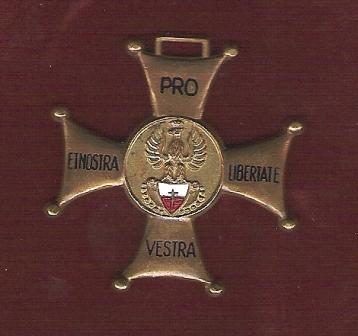 0
0 -
Hello again Martin,
Have been looking in this website http://www.silvercollection.it/englishsilvermarksXCDUE.html and I found this:see pic.
Is this the mark CR over WS on your snake? It's a London Hallmark of 1841. CR stands for Charles Rawlings, WS for William Summers.
Graham thank you for your answer, most helpful.
Kind regards,
Jef
 0
0 -
I have just purchased a set of the snake head buckle and clasp in silver, hallmarked 1856 Birmingham. Maker's mark looks like CRWS.
I have a recollection of having seen similar on pouch belts or cross belts of the Victorian and Georgian periods, probably worn by cavalry officers.
Martin Russell
Hello Martin,
Thank you for your interest in this topic. Birmingham was well known for its engravers, medal-, badge- and buttonmakers. In general for its copper and brass wares. Never heard these snakes also exist in silver.
Kind regards,
Jef
0 -
Hello again, Rittmeister,
I still have been looking for the buttons and look what I found in http://www.histoire-collection.com/catalog_300.html . I think this button is the one you are looking for: Infanterie Marine/Infanterie Coloniale.
I was wrong to think about Belgian buttons, sorry. If the buttons belong to the greatcoat, there is a big chance the greatcoat is French. I'm sure there are gentlemen on this forum who knows more about French Naval Units than I do, maybe they can confirm this.
kind regards,
Jef
 0
0 -
Hello Rittmeister,
Indeed, the buttons shows a navy motives. I have been looking in http://www.knopfsammler.de/main_index.html and I could not find the buttons you showed. Most of the navy buttons have a crowned anchor. The anchor in fantasy buttons have often a ropeshaped border. However, buttons of the Belgian Infantry of the Line used in 1914 almost the same ornament, altough there is a little difference.And of course the number of regiment is changed into an anchor.... I used a pic of the knopfsammler website. I was not able to find French navy buttons. Maybe we have to look in that direction?
Sorry, I couldn't be more helpful.
Jef
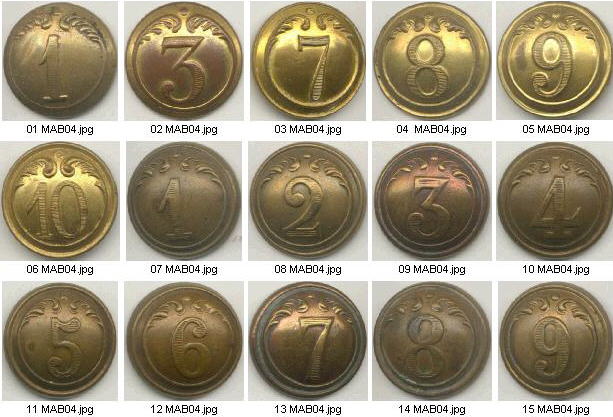 0
0 -
Hello Rittmeister,
http://www.freewebs.com/abl1940/overjassenenmantels.htm is a good website to compare the photographs. In fact I never saw a Belgian overcoat with a seam under the chin, between the upper buttons. And the upper buttons are hidden under the collar. I have put an overcoat on my scanner:
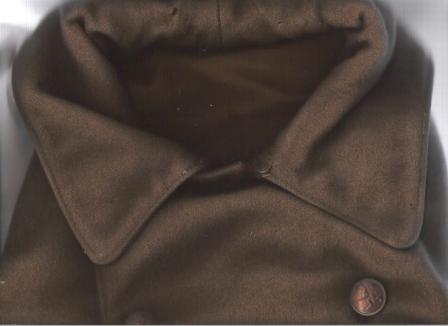
A lot of Belgian soldiers were released from POW camp late 1940 and returned home. Others stayed longer in Germany or Austria. I have in my collection a uniform of my late neighbour. He had to work in Austria on roadworks till 1942. His Belgian uniform was totally worn out. He told me he received other clothes from the Red Cross: it's a British Battle Dress from 1938 and a Polish trouser. In these clothes he got home in 1942.
Maybe the overcoat in your pic is also a captured piece of uniform?
Kind regards,
Jef
0 -
And another view which must have been familiar to your father in law.
Best wishes,
Jef
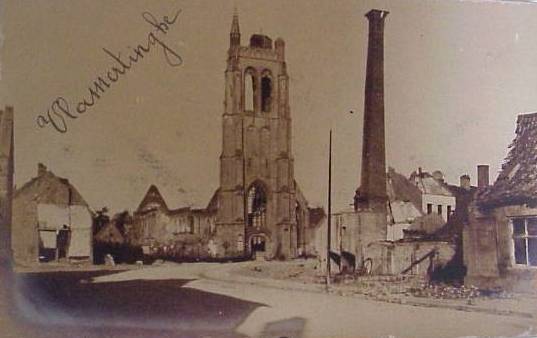 0
0 -
Hello again,
During my search for a photograph I found these pics. It's chateau des Rosiers in Vlamertinghe. Before and during the war. I must say it's a bit confusing.... Did your father in law mentioned the name of the castle?
Jef
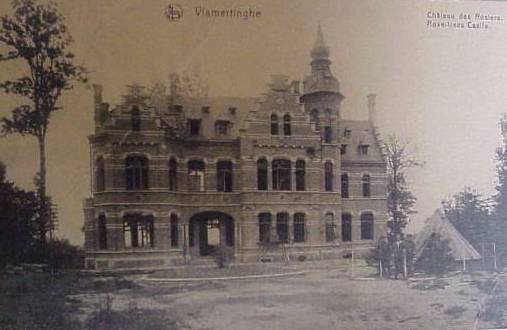
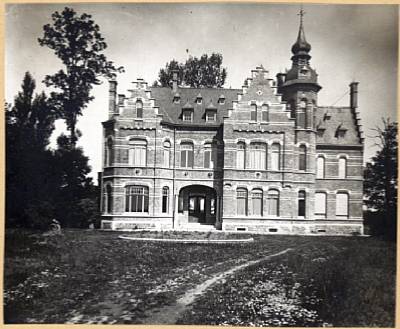 0
0 -
Hello Jim,
Enclosed is a pic of the castle before WWI.Sorry no damage yet.
Jef
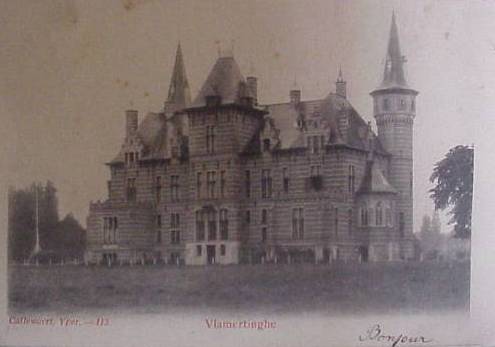 0
0 -
Thanks Jeff. Much appreciated. Still feel that somewhere out there there must be a picture showing the damage.
Jasmor58
Hello Jasmore,
The Chateau is situated in the hospitaalstraat in Vlamertinge. It was built in 1857-1858 for viscount Pierre-Gustave du Parc by architect J. Schadde of Antwerp. During WWI the castle was occupied by different allied units. In this way the castle and its property became a German target. It was restored in 1920 by V. Carron of Ardooie. Recently I learned R. Duflou wrote several publications of Vlamertinge. I hope i will be able to find the requested information. Meanwhile i add a pic of Vlamertinge village. I'm sure this environment was familiar to your father-in-law.
With kind regards from Flanders,
Jef
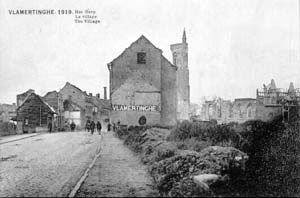 0
0 -
Hello Jasmor,
You are quite right, the first pic i sent was the castle of Elverdinge, a village nearby. I continue to look for a wartime pic of Vlamertinge castle. Sorry to bring you on a wrong track.

Kind regards,
Jef
enclosed is a pic of the backside of the castle
 0
0 -
Jeff,
Sorry, but I omitted to say that it would also be interesing to see the pictures from the thirties. Just to see how the reconstruction was.
I did not think that the Chatea had been so badly damaged.
regards,
Jasmor58
Hello Jasmor,
I found the pic on the internet, i will look for the link.
Jef
attached is the frontside, will make a scan of the backside from a postcard in my collection
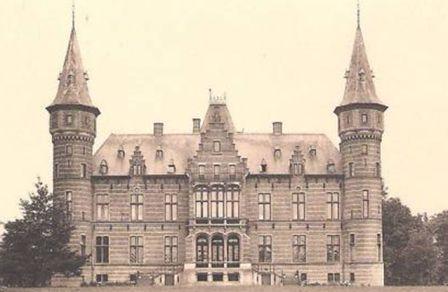 0
0 -
Does anyone have , or know of any, wartime photographs of Vlamertinghe Chateau in Belgium? Any help would be greatly appreciated. My fater-in-law was posiotioned here with 154 Siege Batteryi9n 1918.
Regards,
Jasmor58
Hello Jasmor,
Attached is a pic of the castleruins. After the war, the castle was restored. I don't know if you want pics of the castle in the thirties?
regards,
Jef
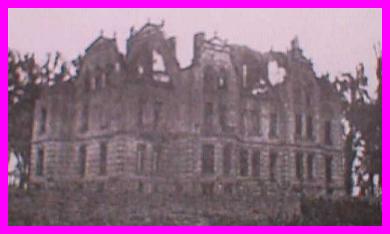 0
0 -
Dear Bovec, Jeff and Emanuel,
Thank you for your answers. We are quite sure about the St. Sava of Capt. Jett. He got this medal together with a Serbian Red Cross medal. My friends were told that Private Garwood also received a St. Sava. But Patrick and Chris were not able to find more information. Now, I know why.
@Emanuel, Patrick is doing fine. Chris and Patrick are working on this book about six years. They asked me to read the manuscript... almost 700 pages of detailed information. They did a tremendous job, there is a review about every doughboy buried or commemorated in this cemetery. I wish them every succes with the book.
Again, many thanks for your help,
Jef
0 -
Hello Gents,
I was wondering if someone of you have a list of recipients of the Order of St Sava?
Two close friends of mine are going to publish a book in the near future about the American Cemetery Flanders Fields, Waregem, Belgium. It was told two Americans connected to this cemetery have the Order of St Sava, I'm afraid I don't know which class.
Private Roy F. Garwood,N°1750082 Co K. 148th Inf. Rgt., 37th Division. KIA 2/11/1918, Buried in Flanders Fields Belgium
Captain Richard L. Jett, Medical Reserve Corps att.BEF, KIA 13/4/1918. Commemorated on the Wall of Missing Flanders Fields, Waregem Belgium.
I would be very grateful if someone could verify this.
Kind regards from Flanders,
Jef
0 -
Thank you Lion. Good info for my data base!
Hello,
Special for your data base. Attached is a pic of the bronze medal( back side) and the gold medal (front side).This is a non official medal
Kind regards,
Jef
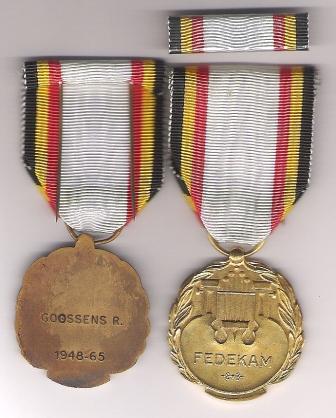 0
0 -
I agree, I have seen these Leopold 1 Officers with a plain (Knight class) ribbon for sale and it only adds to the confusion of an already confusing award structure (for me anyway).

So, I know I need a ribbon with a rosette here, but do I also need to have one with the crossed swords as this particular one is from the military division? I believe this one dates from the early 1900's up to...1950ish, but I don't know the minute detail differences in crown styles, enameling, etc.
Tim
Hello Tim,
Have you ever tried this address: http://www.eekelers-centini.be/catalog/ind...hp/cPatch/32_37
kind regards,
Jef
0 -
hello gents,
I do think he is a genuine war hero, but I also think he knew the decoration system and asked for almost everything he could get, even if some medals are conflicting with each other, like our fellow member explained with the british ones.
The foreign legion is perhaps the most decorated regiment in the world and it's soldiers have seen a lot of different action in WW2.
Therefore I don't think it is weird he has a lot of decorations, he has seen a lot of action, and probably not just regular action too if you look as some of the places as well as resistance medals.
For the people that know/play the games like medal of honor and call of duty, in those games you often play a special soldier, a person that often really existed and has seen a lot of countries and resistance actions. This guy could be a story for such a game.
A war hero,but perhaps he should not have worn some medals.
which medal is this?:
M?daille de S./Officier de l?Arm?e Belge, brevet en date du 01/05/67
Hello Roeland,
Is this the medal you are asking for?
F?d?ration Royale des Ex-Sous Officiers de 'l Arm?e Belge/ Koninklijke Federatie van Oud-Onderofficieren van het Belgisch Leger. It's a non official medal.
Kind regards,
Jef
http://gmic.co.uk/uploads/monthly_12_2008/post-761-1230481863.jpghttp://gmic.co.uk/uploads/monthly_12_2008/post-761-1230481888.jpg
0




Belgian badges
in Northern European & Baltic States
Posted
Separate crowns were used in headdress, as collarbadges, in shoulderboards. Alone or in addition with numbers, crossed sabres, crossed rifles, crossed lances...
Kind regards from Flanders,
Jef